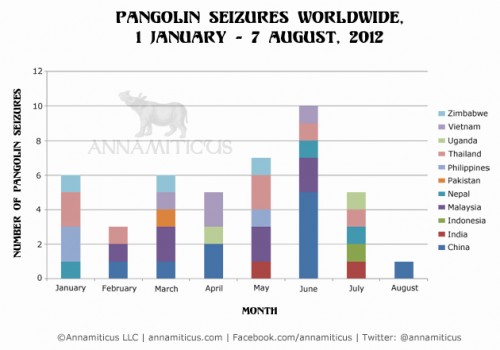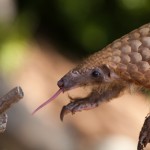
The number of pangolin busts made during the first seven months of this year has doubled those made during the same time period in 2011.
An estimated 2,100 – 2,600 (or more) pangolins have already been seized in at least eleven countries worldwide. Considering that experts say wildlife seizures represent only about 20 percent of the actual illegal trade, pangolin seizures to date suggest that 10,500 – 13,000 pangolins could have been plundered from the wild during the first seven months of 2012.1
Illegal shipments of pangolins and their scales are most often headed for China, where the flesh is consumed as a “delicacy”, while scales and fetuses are eaten for “health purposes.”
- 1 January – 31 July, 2011: At least 22 pangolin seizures were made
- 1 January – 31 July, 2012: At least 43 pangolin seizures were made
More busts, less volume
While 2012 has had a higher number of reported busts, the volumes (of live and dead pangolins, as well as scales) are smaller compared to 2011.
Pangolins:
- 1 January – 31 July, 2011: The estimated equivalent of more than 6,000 individual pangolins were seized – and perhaps as many as 9,600 or more
- 1 January – 31 July, 2012: The estimated equivalent of more than 2,100 individual pangolins were seized – and perhaps as many as 2,600 or more
Scales (no carcasses):
- 1 January – 31 July, 2011: Scales (alone) were seized at least five times (yielding an estimated equivalent of over 530 individual pangolins – and perhaps as many as 750 or more), totaling more than 809 kg.
- 1 January – 31 July, 2012: Scales (alone) were seized at least eleven times (yielding an estimated equivalent of over 450 individual pangolins – and perhaps as many as 890 or more), totaling more than 1,990 kg.
Uncertain future for pangolins
Not all confiscated pangolins are dead; some are returned to the wild. However, it is possible that even those released may not survive, due to stress and trauma incurred under undesirable captive conditions. Scientists are currently working to gain a better idea of post-release survival rates for the scaly anteaters.
And despite the enormity of illegal trade in pangolins, this species is rarely discussed at Convention on International Trade in Endangered Species (CITES) meetings.
(Edited by Rhishja Cota-Larson)
1. Figures and calculations stated in this article have been derived from known media reports and reports from wildlife trade-monitoring organizations (e.g. TRAFFIC, ASEAN-WEN, etc.). As further information becomes available, these numbers are subject to change.
Image © iStockphoto.com; chart © Annamiticus.


![Indonesia: Pangolin Smugglers Doing Their Dirty Work [Photos]](https://annamiticus.com/wp-content/uploads/2013/10/PangolinsArrive-150x150.jpg)

![Pangolin Trafficking: 2011 to August 2013 [Infographic]](https://annamiticus.com/wp-content/uploads/2013/08/PangolinsInTrade2011thruAugust2013-150x150.jpg)
